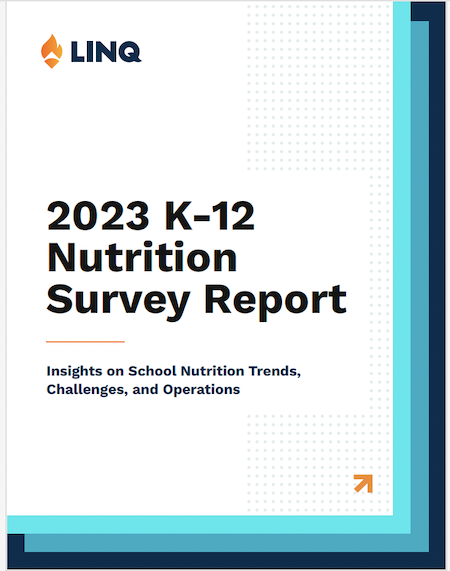Our 2023 K-12 Nutrition Survey Report finds that over 70% of districts polled still conduct manual back-office tasks. Less than a quarter say they’re partially or fully automated. For smaller districts with less than 1,000 students enrolled, 48% report their back office operates with all or mostly manual processes.
Meanwhile, our survey also finds that the top two concerns of Food Service Directors are rising costs and staff shortages. Schools and districts still relying on manual processes can drastically improve operational efficiency and reduce staff workload by automating processes and eliminating redundant tasks. This translates to cost savings and more time for team members to focus on their most important tasks. Those could be big wins against two of the toughest challenges facing K-12 nutrition programs in 2023 and beyond.
In this blog post, we look at four ways automation can help school nutrition programs improve efficiency, save time and money, and reduce strain on nutrition managers and staff.
Save time by automating K-12 nutrition inventory and production records
Managing inventory and production records can be some of the most time-consuming tasks for K-12 nutrition teams. Doing it all by hand, with clipboards, pencils, and manually updated spreadsheets drags down efficiency and can keep staff from completing more impactful tasks like menu planning, program promotion, and scratch cooking. While accurate inventory and production records are fundamental to school food service, they hamper success when completing them dominates staff members’ already busy schedules.
A modern K-12 nutrition system automates inventory and production record updates. By integrating front-of-house (FOH) and back-of-house (BOH) systems, point-of-sale (POS) data can immediately feed into the inventory and production record system as each sale is made. That means real-time inventory and production record updates without consuming a second of staff member time. Instead of reconciling sales records with inventory records, current stock, and recipes, an integrated nutrition software solution does it all for staff members.
Improve data accuracy with nutrition software automation
Time savings via automation offers huge efficiency gains, but that’s not the only advantage. Automated data updates also eliminate human errors due to math mistakes, misread handwriting, or incorrect data pulls. That means accurate information in real-time—the secret sauce of data-driven decision making. It also means more confidence in reports pulled for stakeholders, team members, and district leaders.
Accurate data also contributes to less waste by taking the guesswork out of current stock and vendor orders. A modern system integrates inventory and production records and enables ordering from within the software. That means kitchens get exactly what they need, nothing they don’t, and there’s less chance that any ingredients or products go to waste. With rising food costs a top concern, it’s vital to make every purchase count.
Ensure worry-free K-12 nutrition compliance with automated temperature recording
Compliance practices like recording refrigeration temperatures are essential to food safety and delivering healthy meals, but manually handling these tasks takes time. Mistakes or forgotten temperature recordings can even result in costly compliance infractions, even if food quality wasn’t compromised. Automating daily temperature recording can save time and money while ensuring food safety and compliance.
How does a software solution automate temperature logging? A modern solution that incorporates wireless digital thermometers can automatically record refrigeration temperatures throughout the day. This gives program managers added assurance that their units work correctly, and it keeps schools compliant. Best of all, staff members don’t need to spend extra time writing down temperatures and then entering them into a computer later.
Manage tight nutrition budget constraints with smart automation investments
Money and time spent wisely return big dividends in the long run—and that’s the number one reason to invest in modern K-12 nutrition program technology. Resources devoted to updating or upgrading systems now can deliver improved efficiency for years to come. That leaves a larger portion of future budgets available for other program enhancements like kitchen equipment improvements, staff wellbeing initiatives, and nutrition program promotion to drive more student participation. Time saved by more efficient technology systems can give staff members and managers more time to focus on program expansions like à la carte sales, scratch cooking, and catering.
Reduce meal debt by making life easier for families
In addition to reducing costs and saving time and stress for staff, digitizing school nutrition management can also make life easier for families. For example, a digital payments solution lets families load student meal accounts from anywhere, pay outstanding balances quickly and easily, and avoid problems like lost or stolen cash. Simplifying meal payments with an online solution can help to reduce student meal debt by removing account settlement barriers.
A modern K-12 nutrition solution can also facilitate meal application collection to help reduce meal debt. Our survey reveals that 57% of respondents grade their program at an A or B for managing meal debt when they rate meal application collection as “Excellent” or “Very Good.”
For districts struggling to get meal applications completed, communication may be the issue. Many families may simply be unaware of forms they’re supposed to complete for free and reduced meals. LINQ Vice President of State Nutrition recently told the74million.org that communicating changes is widespread. “Access and people even understanding that they were required to fill out those forms was a bit confusing,” he says.
Automating direct certification, clearly communicating with families, and giving them online access to meal applications can go a long way toward settling meal debts and increasing reimbursements. A digital solution can automate communication and access via system alerts and reminders that link to online self-service meal application forms and directions.
Partner with LINQ to automate K-12 nutrition program operations
Rising costs, staff shortages, and tightening budgets make automation a vital ingredient for nutrition program success. Fortunately, solutions already exist to take your program from where you are to fully automated efficiency.
Partner with LINQ to save time and money, freeing up more resources for initiatives you want to pursue for your program. We offer the only fully integrated solution for FOH and BOH management, an industry-leading digital payments solution, and experienced team support to help you achieve your automation goals.
LINQ offers K-12 nutrition programs:
- The only fully integrated FOH and BOH solution
- Easy food and supply ordering from within the system
- Automated Bluetooth refrigerator thermometers
- Simplified digital payments and fee management
Working together, we can build a school nutrition software solution that takes on the heavy lifting and frees your staff to devote more energy toward delivering healthy, nutritious meals to learning, growing students.
Get more insights from our survey of K-12 nutrition programs across the U.S. in our comprehensive report.

